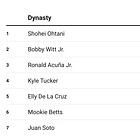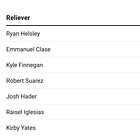Fantasy Baseball 2025 Redraft Top 500 Rankings & Trade Value Version 2.10
Kris Bubic. Yusei Kikuchi. Max Meyer. Anthony Bender. And Brady Singer.
We’ve got a (nearly) a week’s worth of data and there’s plenty of change in this week’s top 500. A lot of it in fact.
There’ll be some more notes later on in an unintentionally pitcher-heavy column, but there’s a lot of data to process and work through for the season’s first (close to a) week.
The result? We have some early-season pitchers to consider who maybe didn’t have this much fantasy relevance a few months ago (hello Kris Bubic and Anthony Bender among others) plus a look at a former top prospect who thrived to start the year. Spoiler alert, the pitcher is a National Leauge pitcher. Ok, so that really doesn’t narrow it down with Meyer and Singer. You know what? … It’s Meyer. But more on him shortly.
At any rate, we’ve got a lot to cover, let’s dive into the rankings and analysis.
(A quick note, if you’re having trouble reading the table in full in the Substack app, it can be viewed in full either in the email or in a web browser.)
If you have any questions about trade offers, the waiver wire, last minute start/sit options, roster construction strategies, or anything specific to your fantasy team, becoming a paid subscriber grants you access to my daily fantasy help chat where I’ll be answering all of your fantasy baseball questions every weekday, whether it’s redraft or dynasty, or during the offseason, draft season, the regular season or the fantasy playoffs. The main goal of this Substack? To help you win your fantasy leagues.
Kris Bubic (#241, 25 trade value).
Early in his career, Kris Bubic logged FIP numbers of 5.14 and 4.78 in two seasons in the Kansas City Royals rotation in 2021 (130 innings pitched) and 2022 (129 innings pitched) respectively. His strikeout rate never climbed over 21% in either of those seasons, and his walk rate was a bit over 10.0% (it was 10.6% and 10.7% respectively) in both of those seasons.
Last season, the 27-year-old made all of his Major League appearances in the team’s bullpen, and the results were noticeably better.
Of course, many times when starters switch to relief roles, the stuff plays up and strikeout rates can be higher due to the shorter stints, but Bubic was excellent as a reliever.
He registered a 32.2% strikeout rate compared to just a 4.1% walk rate in 30.1 innings, limiting batters to a 2.6% barrel rate and a 28.6% hard-hit rate in the process.
Now back in the rotation after a solid spring, Bubic shined in his first start of 2025, limiting the Milwaukee Brewers – in Milwaukee – to three hits and two walks in six shutout innings while striking out eight batters on 95 total pitches.
Bubic registered a (to put it plainly) really, really good 35% CSW rate on the day to go along with 15 swinging strikes, 11 of which came via his four-seamer.
He’s the type of early-season pitching addition (the next pitcher on this list is another) who fits the strategy of overwhelming your opponents in head-to-head leagues with rotation innings volume to a tee.
Max Meyer (#198, 38 trade value).
Meyer, just like Bubic, was really good in his first start of the year.
The former first-round pick threw 5.2 innings against the Pittsburgh Pirates, limiting the National League Central club to five hits, two runs (one earned), a walk and a home run on the day. Mayer struck out seven Pirates hitters on 93 pitches while registering 12 swinging strikes and a 34% CSW rate.
There was a lot to like about what Meyer did, the question now becomes how sustainable is it?
And not necessarily from a Meyer being effective on the mound standpoint.
This is all purely speculative, mind you, but the Marlins did limit the right-hander’s innings significantly last season. If they did so again it would obviously limit Meyer’s 2025 fantasy ceiling considerably, at least compared to similar starters.
Furthermore, and again this is all speculative, would the Marlins trade Mayer? Sandy Alcantara looks (speculatively speaking) like one of the league’s top trade candidates. Alcantara is 29. Mayer, though controllable through 2028 via arbitration per Spotrac, is 26.
Furthermore, if the Marlins did trade Meyer, there’s also the possibility he’d be dealt to a team with a hitter-friendly haven of a ballpark. We’ve seen what ballparks in Colorado and Cincinnati have done to pitchers’ fantasy ceilings. A similar type of move would not be ideal for Meyer.
By the same token though, in the hypothetical scenario where Meyer is traded, a move to a more pitcher-friendly ballpark would do wonders for his long-term fantasy ceiling.
Add it all up and there’s a lot of uncertainty, at least compared to some other starters.
That’s not to say you shouldn’t add Max Meyer if he’s available via waivers. You absolutely should. Just keep all that in mind when you do.
Yusei Kikuchi (#149, 50 trade value).
Overreactions always happen this early in the season. A manager might drop a player far before they actually should (and oftentimes in a rash, unnecessary move). The same can apply to trades, with some fantasy managers dealing players away far too soon.
This might apply to Yusei Kikuchi.
The 33-year-old shined last season, pitching to a 4.05 ERA and a 3.46 FIP in 32 starts spanning 175.2 innings of work. He struck out a career-high 28% of batters while limiting batters to a 6.0% walk rate.
Now with the Los Angeles Angels, Kikuchi is the resident ace in Anaheim now, and his first start wasn’t exactly on par with his 2024 numbers, at least at first glance.
Facing the Chicago White Sox, Kikuchi surrendered five hits, three earned runs and a home run in six innings against the American League Central club. He also struck out five batters.
And while the strikeouts could’ve been better, Kikuchi still registered a 30% CSW rate.
The veteran’s second start wasn’t quite as good. He logged a 24% CSW rate and 11 swinging strikes in six innings against the St. Louis Cardinals, allowing four hits, three earned runs, five walks and a pair of home runs in the process. Kikuchi struck out six on the day.
I wouldn’t give up anything significant for him in a trade, but he should be better long-term. If you’re working on a larger deal for a potential impact fantasy player, try acquiring Kikuchi as the secondary or tertiary player in that deal framework, or in something extremely minor if another manager is considering dropping him.
Brady Singer (#315, 17 trade value).
I’m skeptical of Singer’s long-term fit in Cincinnati from a fantasy perspective, but his first start was excellent.
The former Royals hurler scattered a hit and two walks in seven shutout innings against the Texas Rangers, striking out eight, logging a strong 32% CSW rate and registering at least four swings and misses with each of his sinker, four-seamer and slider. Keep an eye on Singer’s production over the next few starts/weeks.
Anthony Bender (#294, 21 trade value).
If the Marlins continue trading veterans this summer, as they have recently, it certainly wouldn’t be a surprise to see presumed some late-inning relievers get traded.
Calvin Faucher, who looked like the closer heading into the year (at least speculatively speaking) would certainly fit the bill in that regard. Again, this is all entirely speculative on my part.
And while Anthony Bender might end up getting traded as well, he’s very much worth a look for those in search of saves. Because, if recent trends continue, he could very well be the Marlins’ closer.
The 30-year-old pitched to a 4.08 ERA and a 2.92 FIP in 53 innings (59 appearances) last season striking out 25.9% of the batters he faced while logging a 7.9% walk rate.
Bender was particularly efficient at limiting barrels and quality contact. Opposing batters managed just a 4.8% barrel rate against the 30-year-old, a number that ranked in the 91st percentile league-wide for the right-hander.
Elsewhere, the reliever held batters to a .288 xwOBA and a .346 xwOBAcon with a sweeper and sinker-heavy arsenal. The 30-year-old’s sweeper in particular was extremely effective, sporting a 45.4% usage rate, the pitch limited batters to a .170 batting average, a .152 xBA, a .222 wOBA and a .200 xwOBA.
So far this season, Bender already has a save and a win in three scoreless appearances, totaling 2.2 innings for the Marlins in 2025. Perhaps most crucially, he already has two high-leverage ninth-inning appearances. Kenley Jansen and three other relievers (Luke Jackson, David Bednar and Andres Munoz) currently pace baseball with three. No other Marlins reliever has more than one.
It’s early and the Marlins’ bullpen usage so far might have been more of a product of matchups, but Bender looks like he’ll at worst be part of a saves committee.
Miami isn’t likely to supply a ton of save chances, but saves are saves and Bender is very much worth a look for those chasing saves at the moment, particularly for those looking to replace saves production from the likes of David Bednar or Alexis Diaz.
Beware the Open Roster Spot (Or lack thereof)
Oh and one more quick note, beware the open roster spot, or lack thereof rather, in trades.
While a two-for-one or even a three-for-one or four-for-two deal might line up from a trade value standpoint, the roster spots are worth considering. Essentially, if you’re having to cut someone, it turns into you giving up another player or players in addition to potentially the best player in the deal. It’s obviously a different story if you’re working with a flexible roster or open roster spots, but it adds another layer to deals that can potentially change the calculus of things considerably.
New Weekly Column Alert! (Check out last week’s column for free!)
Check out week 2’s column below. Really excited about this new weekly feature.
League Winners Week 2: All the Hitters
It’s a decidedly hitter-heavy League Winners column this week. And while that certainly wasn’t the intent from the start and not something that’ll happen every week, but it’s hard to ignore the starts that these hitters have gotten off to.








